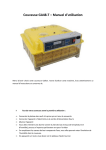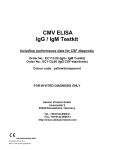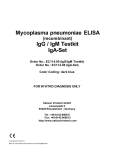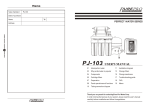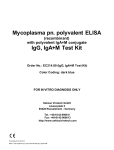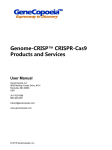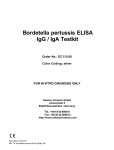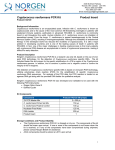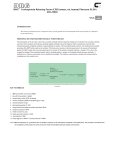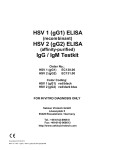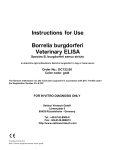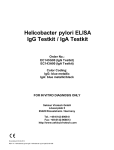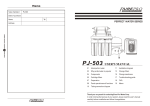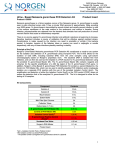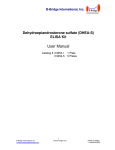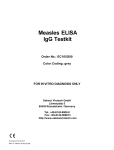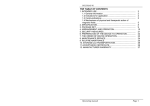Download Package Insert - Sekisui Diagnostics
Transcript
Mumps ELISA IgG / IgM Testkit Order No.: EC106.00 Color Coding: light green/transparent FOR IN VITRO DIAGNOSIS ONLY Sekisui Virotech GmbH Löwenplatz 5 65428 Rüsselsheim / Germany Tel.: +49-6142-6909-0 Fax: +49-6142-966613 http://www.sekisuivirotech.com Druckdatum 03.02.2014 REV 11 / Mumps ELISA IgG/IgM GB Contents 1. Intended Use ......................................................................................................................... 3 2. Diagnostic Relevance ............................................................................................................ 3 3. Test Principle......................................................................................................................... 3 4. Package Contents (IgG and IgM Testkit) ................................................................................ 3 5. Storage and Shelflife of the Testkit and the ready to use reagents ....................................... 4 6. Precautions and Warnings .................................................................................................... 4 7. Material required but not supplied......................................................................................... 4 8. Test Procedure ...................................................................................................................... 5 8.1 8.2 8.3 8.4 9. Examination Material....................................................................................................................................................... 5 Preparation of Reagents ................................................................................................................................................. 5 Virotech ELISA Test Procedure....................................................................................................................................... 5 Usage of ELISA processors ............................................................................................................................................ 6 Test Evaluation ...................................................................................................................... 6 9.1 9.2 9.3 9.4 Test function control........................................................................................................................................................ 6 Calculation of the Vir otech Units (VE) ............................................................................................................................. 6 Interpretation Scheme IgG and IgM ................................................................................................................................ 6 Limits of the Test............................................................................................................................................................. 7 10. Performance Data .................................................................................................................. 7 10.1 10.2 10.3 10.4 Sensitivity and Specif icity ................................................................................................................................................ 7 Prevalence (Expected Values) ........................................................................................................................................ 7 Intra-assay-Coefficient of Variation (Repeatability).......................................................................................................... 9 Inter-assay-Coefficient of Variation (Reproducibility)....................................................................................................... 9 11. Literature ............................................................................................................................... 9 12. Test Procedure Scheme ...................................................................................................... 10 Seite 2 v on 10 Mumps ELISA IgG/IgM GB REV 11 Druckdatum 03.02.2014 1. Intended Use The Mumps ELISA IgG / IgM is intended for the semiquantitative and qualitative detection of IgG- and IgM-antibodies against Mumps viruses in human serum. The IgM-antibody determination is used for diagnosing acute infections and the IgGantibody determination for detecting the serostatus. 2. Diagnostic Relevance The mumps virus belongs to the family of the Paramyxoviridae. The Paramyxoviridae also include measles, parainfluenza and RSV. Humans are the only natural host for the mumps virus, w hich is distributed w orldw ide. (1) In the developed countries of the northern hemisphere, the highest incidence is among 5- to 9-year old children. Above the age of 15 years, 80-90% have been infected. As the contagiousness of mumps viruses is only 40% compared to measles and varicellas, disease occurs in adults about three times more often than w ith measles. (1) About 30-50% of infections have a silent course and life-long immunity is usually acquired follow ing infection. (2,4) The mumps virus is spread from person to person through saliva droplets or nasal secretion. (1) The incubatio n period is 1821 days, after w hich the classical lead symptom of unilateral or bilateral febrile parotitis occurs w ith obvious sw elling. (3 ) Most mumps virus infections (synonym: epidemic parotitis) follow a course of generalised self -limiting illness. How ever, complications can occur, particularly w ith increasing age. Orchitis, w hich is usually unilateral, occurs in about 20% of postpubertal patients. If it is bilateral, there is a danger of testicular atrophy w ith subsequent infertility. In 10% of cas es in the first decade of life, meningitis can occur as a complication, usually benign but w ith the rare late sequela of deafness. In t he first trimester of pregnancy, there is a risk of abortion; how ever, embryopathy is unknown. Other possible complications such as epidydimitis, oophoritis, meningoencephalitis, mastitis or pancreatitis should be noted. (1) The disease alw ays commences with fever and in most cases w ith unilateral parotid sw elling. This is easy to recognise by lifting the earlobe. In 2/3 of cases, the other side is also affected later. Occasionally, only the submaxillary and sublingual glands are affected w ithout discernible parotid involvement. (1) Referring to Buxbaum still more than 20% of the 15 to 19 year old teenager show a lack of immunit y against the mumps virus. Serum samples w ith a rate of >90% (5) of protective antibodies are only found in the population aged 40 years or older. Vaccination against mumps is generally recommended, and is usually carried out w ith a live vaccine (MMR). Wit h this vaccine the conversion rate is 95%. Vaccination should be considered for children and exposed adults. (1) The diagnosis is made from the lead symptom of parotitis. The virus can be isolated from saliva samples. (1) Serological test systems, in particular, are suitable for laboratory diagnosis. ELISA, KBR or HHT are employed. The virus can also be detected directly by PCR. Parotitis from other causes such as Coxsackie viruses, EBV, parainfluenza, influenza A or adenoviruses must be considered in the differential diagnosis. Bacterial pathogens such as staphylococci or atypical mycobacteria and also fungal infections should also be included in the differential diagnosis. (1,4) ELISA test systems are particularly suitable for routine use in serology to distinguish the different immunoglobulin classes. Acute mumps virus infection can be confirmed even in the first days of illness by the detection of specific IgM antibodies. ( 3) The specific IgM antibodies are usually detectable for a month (3). IgG antibodies are also detectable tw o w eeks after the start of the illness (3) and persist for many years (4). 3. Test Principle The antibody searched for in the human serum forms an immune complex w ith the antigen coated on the microtiter -plate. Unbound immunoglobulins are removed by w ashing processes. The enzyme conjugate attaches to this complex. Unbound conjugate is again removed by w ashing processes. After adding the substrate solution (TMB), a blue dye is produced by the bound enzyme (peroxidase). The color changes to yellow w hen the stopping solution is added. 4. Package Contents (IgG and IgM Testkit) 1. 2. 3. 4. 1 Microtiter-Plate consisting of 96 with antigen coated, breakable single w ells, lyophilised PBS-Dilution Buffer (blue, ready to use) 2x50m l, pH 7,2, w ith preservative and Tw een 20 PBS-Washing Solution (20x concentrated) 50m l, pH 7,2, w ith preservative and Tw een 20 IgG negative Control, 1300µl, human serum w ith protein-stabilizer and preservative, ready to use Seite 3 v on 10 Mumps ELISA IgG/IgM GB REV 11 Druckdatum 03.02.2014 5. 6. 7. 8. 9. 10. 11. 12. 13. 5. IgG cut-off Control, 1300µl, human serum w ith protein-stabilizer and preservative, ready to use IgG positive Control, 1300µl, human serum w ith protein-stabilizer and preservative, ready to use IgM negative Control, 1300µl, human serum w ith protein-stabilizer and preservative, ready to use IgM cut-off Control, 1300µl, human serum w ith protein-stabilizer and preservative, ready to use IgM positive Control, 1300µl, human serum w ith protein-stabilizer and preservative, ready to use IgG-Conjugate (anti-human), 11ml, (sheep or goat)-horseradish-peroxidase-conjugate with protein-stabilizer and preservative in Tris-Buffer, ready to use IgM-Conjugate (anti-human), 11ml, (sheep or goat)-horseradish-peroxidase-conjugate with FCS and preservative in Tris-Buffer, ready to use Tetramethylbenzidine substrate solution (3,3’,5,5’-TMB), 11m l, ready to use Citrate-Stopping Solution, 6m l, contains an acid mixture Storage and Shelflife of the Testkit and the ready to use reagents Store the testkit at 2-8°C. The shelf life of all components is show n on each respective label; for the kit shelf life please see Quality Control Certificate. 1. 2. 3. Microtiter strips/single w ells are to be resealed in package after taking out single w ells and stored w ith desiccant at 2-8°C. Reagents should immediately be returned to storage at 2-8°C after usage. The ready to use conjugate and the TMB-substrate solution are sensitive to light and have to be stored in dark. Should there be a color reaction of the substrate dilution due to incidence of light, it is not useable anymore. Take out only the amount of ready to use conjugate or TMB needed for the test insertion. Additional conjugate or TMB taken out may not be returned but must be dismissed. Material Controls Status Diluted Undiluted After Opening Microtitreplate After Opening Rheumatoid factor Absorbent Conjugate Tetramethylbenzidine Stop Solution Undiluted, After Opening Diluted After Opening After Opening After Opening After Opening Final Dilution (ready-to-use) Test Samples Washing Solution 6. Storage +2 to +8°C +2 to +8°C +2 to +8°C +2 to +8° (storage in the provided bag w ith desiccant bag) +2 to +8°C +2 to +8°C +2 to +8°C (protect from light) +2 to +8°C (protect from light) +2 to +8°C +2 to +8°C +2 to +25°C Shelflife max. 6h 1 w eek 3 months 3 months 3 months 1 w eek 3 months 3 months 3 months 3 months 4 w eeks Precautions and Warnings 1. 2. 3. 7. Only sera w hich have been tested and found to be negative for HIV -1 antibodies, HIV-2 antibodies, HCV antibodies and Hepatitis-B surface-antigen are used as control sera. Nevertheless, samples, diluted samples, controls, conjugates and microtiter strips should be treated as potentially infectious material. Please handle products in accordance with laboratory directions. Those components that contain preservatives, the Citrate Stopping Solution and the TMB have an irritating effect to skin, eyes and mucous. If body parts are contacted, immediately w ash them under flow ing water and possibly consult a doctor. The disposal of the used materials has to be done according to the country -specific guidelines. Material required but not supplied 1. 2. 3. 4. 5. 6. Aqua dest./demin. Eight-channel pipette 50µl, 100µl Micropipettes: 10µl, 100µl, 1000µl Test tubes Paper tow els or absorbent paper Cover for ELISA-plates Seite 4 v on 10 Mumps ELISA IgG/IgM GB REV 11 Druckdatum 03.02.2014 7. 8. 9. 10. 8. Disposal box for infectious material ELISA handw asher or automated EIA plate w ashing device ELISA plate spectrophotometer, w avelength = 450nm, reference length = 620nm (Reference Wavelength 620-690nm) Incubator Test Procedure Working exactly referring to the Sekisui Virotech user manual is the prerequisite for obtaining correct results. 8.1 Examination Material Either serum or plasma can be used as test material, even if only serum is mentioned in the instructions. Any type of anticoagulant can be used for plasma. Alw ays prepare patient-dilution freshly. For a longer storage the sera must be frozen. Repeated defrosting should be avoided. 1. Only fresh non-inactivated sera should be used. 2. Hyperlipaemic, haemolytic, microbially contaminated and turbid sera should not to be used (false positive/negative results). 8.2 Preparation of Reagents The Sekisui Virotech System Diagnostica offers a high degree of flexibility regarding the possibility to use the dilution buffer, w ashing solution, TMB, citrate stopping solution as w ell as the conjugate for all parameters and for all different lots. The ready to use controls (positive control, negative control, cut-off control) are param eter specific and only to use w ith the plate lot indicated in the Quality Control Certificate. 1. 2. 3. 4. 5. Set incubator to 37°C and check proper temperature setting before start of incubation. Bring all reagents to room temperature before opening package of microtiter strips. Shake all liquid components w ell before use. Make up the w ashing solution concentrate to 1 L w ith distilled or demineralised w ater. If crystals have formed in the concentrate, please bring the concentrate to room temperature before use and shake w ell before use. High IgG-titer or rheumatoid factors may disturb the specific detection of IgM-antibodies and may lead to false positive resp. false negative results. For a correct IgM-determination it is therefore necessary to pre-treat the sera with RFSorboTech (VIROTECH adsorbent). For IgM-controls a pre-absorbent treatment is not necessary. 8.3 Virotech ELISA Test Procedure 1. 2. 3. 4. 5. 6. 7. 8. 9. 10. For each test run, pipette 100µl each of ready to use dilution buffer (blank), IgG- and IgM-positive, negative and cut-off controls as w ell as diluted patient sera. We propose a double insertion (blank, controls and patient sera); for cut-off control a double insertion is absolutely necessary. Working dilution of patient sera: 1+100; e.g. 10µl serum + 1ml dilution buffer. After pipetting start incubation for 30 min. at 37°C (w ith cover). End incubation period by w ashing microtiter strips 4 times w ith 350 – 400µl w ashing solution per w ell. Do not leave any w ashing solution in the w ells. Remove residues on a cellulose pad. Pipette 100µl of ready to use conjugate into each w ell. Incubation of conjugates: 30 min. at 37°C (w ith cover). Stop conjugate incubation by w ashing 4 times (pls. refer to point 3 above) . Pipette 100µl of ready to use TMB into each w ell. Incubation of substrate solution: 30 min. at 37°C (w ith cover, keep in dark). Stopping of substrate reaction: pipette 50µl of citrate stopping solution into each w ell. Shake plate carefully and thoroughly until liquid is completely mixed and a homogeneous yellow color is visible. Measure extinction (OD) at 450/620nm (Reference Wavelength 620-690nm). Set your photometer in such a w ay that the blank value is deducted from all other extinctions. Extinctions s hould be measured w ithin 1 hour after adding the stopping solution! Pls. refer to last page for Test Procedure Scheme Seite 5 v on 10 Mumps ELISA IgG/IgM GB REV 11 Druckdatum 03.02.2014 8.4 Usage of ELISA processors All Sekisui Virotech ELISAs can be used on ELISA processors. The user is bound to proceed a validation of the devices (processors) on a regular basis. Sekisui Virotech recommends the follow ing procedure: 1. Sekisui Virotech recommends to proceed the validation of device referring to the instructions of the device manufacturer during the implementation of the ELISA processor respectively after bigger reparations. 2. It is recommended to check the ELISA-processor w ith the Validationkit (EC250.00) afterw ards. A regular check using the Validationkit shall be proceeded minimum once a quarter to test the accuracy of the processor. 3. The release criteria of the Quality Control Certificate of the product must be fulfilled for each testrun. With this procedure, your ELISA processor w ill function properly and this w ill support quality assurance in your laboratory. 9. Test Evaluation The ready to use controls serve for a semiquantitative determination of specific IgG- and IgM-antibodies. Their concentration can be expressed in Virotech units = VE. Fluctuations resulting from the test procedure can be balanced w ith this calculation method and a high reproducibility is achieved in this w ay. Use the means of the OD values for calculation of the VE. 9.1 Test function control a) OD-values The OD of the blank should be < 0.15. The OD-values of the negative controls should be low er than the OD-values mentioned in the Quality Control Certificate. The OD-values of the positive controls as w ell as of the cut-off controls should be above the OD-values mentioned in the Quality Control Certificate. b) Virotech Units (VE) The Virotech Units (VE) of the cut-off controls are defined as 10 VE. The calculated VE of the positive controls should be w ithin the ranges mentioned in the Quality Control Certificate. If those requirements (OD-values, VE) are not fulfilled, the test has to be repeated. 9.2 Calculation of the Virotech Units (VE) The extinction of the blank value (450/620nm) has to be subtracted from all other extinctions. OD (positive control) x 10 OD (cut - off control) OD (patient serum) VE (patient serum) x 10 OD (cut - off control) VE (positive control) 9.3 Interpretation Scheme IgG and IgM Result (VE) < 9,0 9,0 - 11,0 > 11,0 1. 2. 3. Evaluation negative borderline positive If the measured values are above the defined borderline range, they are considered to be positive. If the measured VE is w ithin the borderline range, no significant high antibody concentration is present, the samples are considered to be borderline. For the secure detection of an infection it is necessary to determine the antibody concentration of tw o serum samples. One sample shall be taken directly at the beginning of the infection and a second sample 5 – 10 days later (convalescent serum). The antibody concentration of both samples has to be tested in parallel, that means in one test run. A correct diagnosis based on the evaluation of a single serum sample is not possible. If the measured values are below the defined borderline range, no measurable antigen specific antibodies are present in the samples. The samples are considered to be negative. Seite 6 v on 10 Mumps ELISA IgG/IgM GB REV 11 Druckdatum 03.02.2014 9.4 Limits of the Test 1. 2. The interpretation of serological results shall alw ays include the clinical picture, epidemiological data and all further available laboratory results. Anti-doublestrand DNA ( dsDNA) sera (ANA, systemic lupus erithematodes) show crossreactivity to the Sekisui Virotech MUMPS ELISA. 10. Performance Data 10.1 Sensitivity and Specificity To determine the analytical sensitivity and specificity of Mumps IgG 302 sera w ere tested in an internal study. Tw o ELISAs of different suppliers were used as reference test. The serapanel contains sera routinely used by the virology of the University Cologne. Reference ELISA VT Mumps IgG Elisa negative borderline positive negative 72 0 0 borderline 2 2 0 positive 12 8 206 12 sera could neither in the Virotech ELISA nor in the tw o reference tests be clearly defined. They are not included in the calculation of sensitivity and specificity. The Virotech Mumps IgG ELISA show s follow ing values: Sensitivity 94,5% Specific ity >99,8% To determine the analytical sensitivity and specificity of Mumps IgM 258 sera w ere tested in an internal study. Tw o ELISAs of different suppliers were used as reference test. The serapanel contains sera routinely used by the vir ology of the University Cologne. Reference ELISA VT Mumps IgM Elisa IgM n= 258 negative borderline positive 1 negative 237 0 borderline 5 0 0 positive 1 1 13 6 sera could neither in the Virotech ELISA nor in the tw o reference tests be clearly defined. They are not included in the calculation of sensitivity and specificity. The Virotech Mumps IgM ELISA show s follow ing values: Sensitivity 92,9% Specific ity 99,6% 10.2 Prevalence (Expected Values) To the determine the Expected Values 80 blood bank sera w ere tested in IgG and IgM. (n=80) negative Seite 7 v on 10 Mumps ELISA IgG/IgM GB IgG IgM num ber (%) num ber (%) 20 25,0 79 98,7 borderline 7 8,7 1 1,3 positive 53 66,3 0 0,0 REV 11 Druckdatum 03.02.2014 Seite 8 v on 10 Mumps ELISA IgG/IgM GB REV 11 Druckdatum 03.02.2014 A further IgG testing resulted in in comparison to a ELISA reference test the follow ing result: (n=40) IgG (%) Virotech (%) ELISA reference test negative 30,0 20,0 borderline 5,0 25,0 positive 65,0 55,0 10.3 Intra-assay-Coefficient of Variation (Repeatability) In one assay, strips of different plates of one batch have been tested w ith the same serum sample. The obtained coefficient of variation is low er then 9%. 10.4 Inter-assay-Coefficient of Variation (Reproducibility) Three sera w ere tested in 10 independent test runs by different persons in different laboratories. The obtained variation coefficient values are low er than 15%. 11. Literature 1. 2. 3. 4. 5. H. Hahn et al.; Medizinische Mikrobiologie; 3. Auflage 2001, S. 554-556 T. Porstmann; Diagnostische Bibliothek Nr. 19, 1994 F. Burkhardt et al.; Mikrobiologische Diagnostik; 1992, S. 362-363 H. Reploh et al.; Lehrburch der Medizinischen Mikrobiologie; 7. Auflage 1994, S. 838 http://www.aerzte-zeitung.de/docs/2002/01/22/012a1301.asp Seite 9 v on 10 Mumps ELISA IgG/IgM GB REV 11 Druckdatum 03.02.2014 12. Test Procedure Scheme Preparation of Patient Samples and Washing Solution ▼ Washing Solution: Fill up concentrate ▼ IgG-Samples – Dilution 1:101 e.g.: 10 µl serum/plasma + 1000 µl Dilution Buffer (Serum Dilution Buffer is ready to use) to 1 liter with aqua dest./demin. ▼ IgM-Samples - Dilution 1:101 Rheumafactor-absorption with RFSorboTech e.g.: 5 µl serum/plasma + 450 µl Dilution Buffer + 1 drop RF-SorboTech, incubate for 15 min. at room temperature. Testprocedure Samples Incubation 30 minutes at 37°C 100 µl Patient Samples blank value (Dilution Buffer) and controls 400 µl Washing Solution Wash 4times Remove Residues on a Cellulose Pad Conjugate Incubation 30 minutes at 37°C 100 µl Conjugate IgG, IgM 400 µl Washing Solution Wash 4times Remove Residues on a Cellulose Pad Substrate Incubation Stopping 30 minutes at 37°C 100 µl Substrate 50 µl Stopping Solution shake carefully Measure Extinctions Seite 10 v on 10 Mumps ELISA IgG/IgM GB Photometer at 450/620nm (Reference Wavelength 620690nm) REV 11 Druckdatum 03.02.2014










